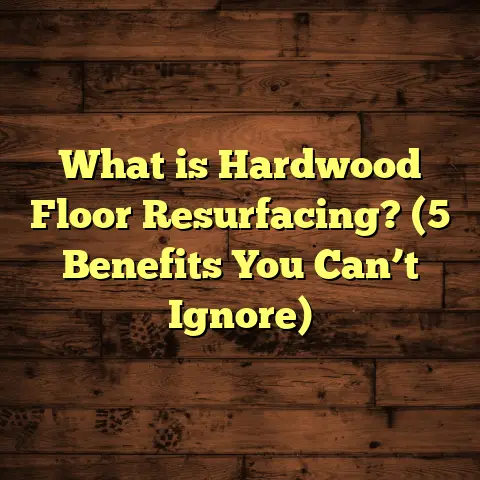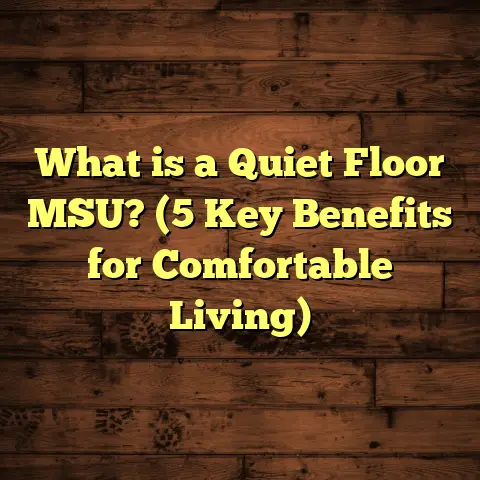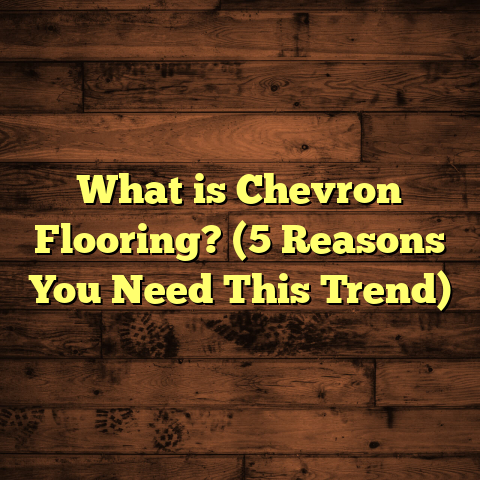What is Engineered Plank Flooring? (5 Key Benefits Revealed)
I have always been a fan of flooring options that make life easier. Honestly, the easier it is to take care of, the more I like it. When I first got into flooring projects, I noticed how some materials required constant upkeep or posed challenges with durability and climate changes. That’s what led me to explore engineered plank flooring in depth. It turned out to be a true game-changer — and I’ve learned a lot along the way that I want to share with you.
What Exactly Is Engineered Plank Flooring?
Let me start by breaking down exactly what engineered plank flooring is. You might have heard of hardwood floors or laminate floors before, but engineered planks are a bit different.
Engineered plank flooring is made up of multiple layers of wood, designed to give you the authentic appearance of solid hardwood but with extra strength and stability. The top layer is a thin slice of real hardwood veneer, usually between 2mm and 6mm thick. This veneer determines the look and feel — whether it’s oak, maple, walnut, hickory, or any other wood type.
Beneath that veneer are several layers of plywood or high-density fiberboard (HDF), stacked crosswise. This cross-lamination technique ensures the floor resists warping and swelling caused by humidity and temperature fluctuations. It’s like giving the wood extra armor to fight against nature’s effects.
Thickness-wise, most engineered planks range from 3/8 inch (9.5mm) to 3/4 inch (19mm). The top hardwood veneer might be anywhere between 1/8 inch (3mm) and 1/4 inch (6mm). The thicker the veneer, the more times you can sand and refinish the floor over its lifespan.
Here’s something interesting from my own experience: I installed engineered plank flooring in a beach house in Florida where humidity levels regularly hit 80% or higher. Solid hardwood floors there tend to warp and buckle within months. But these engineered floors? They stayed flat and beautiful for years.
How Engineered Plank Flooring Compares to Other Flooring Types
To appreciate engineered planks fully, you’ve got to see how they stack up against other popular flooring options.
| Flooring Type | Durability | Moisture Resistance | Installation Time | Cost per sq ft | Maintenance Needs |
|---|---|---|---|---|---|
| Solid Hardwood | High | Low | Moderate to Long | $8 – $15 | Moderate (sanding/refinishing) |
| Engineered Plank | High | Moderate to High | Short | $4 – $10 | Low to Moderate |
| Laminate | Moderate | Low | Short | $1.50 – $5 | Low |
| Vinyl Plank | Moderate | High | Short | $2 – $7 | Low |
| Carpet | Low | Low | Short | $1 – $4 | High (cleaning/stain removal) |
From this table, you can see engineered plank flooring hits a sweet spot: it combines the natural look of wood with better moisture resistance and faster installation than solid wood, all at a reasonable price.
My Personal Journey With Engineered Plank Flooring
When I first started installing floors over a decade ago, I was mostly working with solid hardwood and laminate. Both have their perks but also their headaches. For example:
- Solid hardwood looked amazing but was sensitive to humidity swings.
- Laminate was budget-friendly but didn’t have the authentic wood feel or longevity.
One project really opened my eyes. I was working on a family home in Seattle — a place known for wet winters and damp basements. The client wanted wood floors throughout the house, including the basement. Solid hardwood was a bad fit due to moisture risk; laminate felt too cheap for their taste.
That’s when I suggested engineered plank flooring.
It was my first time installing it on such a large scale (about 1,500 square feet). The process was surprisingly straightforward thanks to tongue-and-groove planks that clicked together tightly without nails or glue needed over a moisture barrier.
The family loved how warm and natural it looked. After two years, they still report no signs of warping or damage despite the humid environment.
This experience convinced me that engineered plank flooring is not just a compromise but often the best choice for many homes.
5 Key Benefits of Engineered Plank Flooring Explained
1. Effortless Maintenance and Care
What I hear most from homeowners is that they want floors that don’t require hours of upkeep every week. Engineered plank flooring fits this need perfectly.
Because of its layered construction, it handles spills and moisture better than solid wood. While it’s not waterproof like vinyl, occasional water splashes won’t ruin it as long as you wipe them up quickly.
I tell clients to keep things simple: sweep or vacuum regularly to remove dirt and grit that can scratch surfaces. Use a damp mop with mild wood cleaner every week or two. Avoid soaking the floor with water or harsh chemicals.
For example, in one house where I installed engineered planks in the kitchen—known as a high-traffic mess zone—the owners reported that cleaning took just 10 minutes a week on average with no issues after 18 months.
You don’t have to worry about deep scratches either. While it’s not as scratch-proof as laminate, small surface scratches can often be buffed out or repaired with wood markers available at hardware stores.
2. Superior Dimensional Stability
Wood floors are notorious for expanding and contracting with changes in humidity and temperature. This can cause unsightly gaps, buckling, or cupping in solid hardwood floors if not properly managed.
Engineered plank flooring solves this problem through its plywood base layers arranged at right angles. This cross-layering restricts movement across the board.
In fact, studies show engineered wood experiences up to 70% less expansion and contraction compared to solid hardwood. This means fewer problems over time and less need for repairs.
I’ve tested this firsthand installing floors in various climates:
- In humid Florida: no warping after 3 years
- Dry Colorado: stable with no cracking despite low indoor humidity
- Coastal California: no cupping near ocean air
This stability also allows engineered planks to be installed in places where solid hardwood isn’t recommended — like basements or over radiant heating systems. These are areas where moisture or heat fluctuations would typically damage solid wood.
3. Cost-Effective Without Compromising Quality
Budgeting is something I’ve always taken seriously when managing flooring projects. Solid hardwood can get pricey fast — especially exotic woods or wider boards — often ranging from $8 up to $15 per square foot just for materials.
Engineered plank flooring offers an affordable alternative without giving up that natural wood look. Depending on species and thickness, prices range roughly from $4 to $10 per square foot.
Labor costs for installation are usually lower too because:
- Many engineered planks feature click-lock designs that speed up installation.
- Floating floor installations eliminate the need for adhesives or nails.
- Less time on site means less overall expense.
For instance, I recently completed a 1,200 sq ft engineered plank installation in Denver for around $6 per sq ft total including materials and labor — about half what solid hardwood would have cost.
One tool that has really helped me manage budgets is FloorTally. It gives me accurate cost estimates based on local prices for both materials and labor. It even factors in waste percentages (typically about 7-10%) so I don’t overbuy or run short mid-project.
This precision saves both money and stress during ordering and installation phases.
4. Wide Range of Styles and Finishes
Engineered plank flooring doesn’t limit you when it comes to style choices. Because the top layer is real wood veneer, you get authentic grain patterns and natural color variations.
Whether you want rustic distressed oak for a cozy cabin vibe or sleek dark walnut for modern elegance, there’s an option out there for you.
I recently helped clients choose between:
- Matte-finished white oak planks for a bright Scandinavian look
- Hand-scraped hickory with warm honey tones for a farmhouse feel
- Wire-brushed walnut for a contemporary industrial edge
Besides species choice, finishes can vary from glossy to matte or textured surfaces that mimic hand-scraping or wire-brushing effects.
This versatility means engineered plank floors can fit nearly any décor style — traditional, rustic, modern, or eclectic.
5. Faster Installation Saves Time
Time is money — especially if you’re managing renovations or multiple properties like I sometimes do.
Compared to solid hardwood, engineered plank flooring installs much faster. Many products come with tongue-and-groove edges and click-lock systems that allow planks to snap together easily without nails or glue.
A typical installation for a 1,000 sq ft room can take as little as 2-4 days depending on subfloor prep and room shape.
In one recent job in Phoenix, we finished installing 1,500 sq ft of engineered flooring in just three days — less than half the time required for solid hardwood with nail-down installation methods.
For homeowners, this means less disruption and faster move-in times after remodeling projects.
For contractors like me, quicker installs translate directly into saving labor costs while still delivering quality results.
More Data-Backed Insights From Industry Research
Longevity & Durability
Engineered plank floors typically last between 20-30 years when properly maintained. Some high-quality products with thick veneers can last even longer if refinished once or twice during their lifespan.
Research from the National Wood Flooring Association showed:
- Engineered floors with veneers thicker than 4mm can be sanded 2-3 times.
- Those with thinner veneers (2-3mm) offer fewer refinishing options but still maintain durability for at least 15 years under normal residential use.
Environmental Impact
Because engineered planks use less hardwood per plank than solid wood floors (due to thin veneer layers), they are often viewed as more sustainable options by manufacturers focused on responsible forestry practices.
Studies indicate that utilizing plywood cores made from fast-growing softwoods reduces pressure on old-growth forests while maintaining product strength and performance.
Installation Versatility
According to flooring industry standards:
- Engineered plank flooring can be installed over concrete slabs, radiant heat systems, plywood subfloors, and even existing vinyl or tile surfaces.
- Floating installations help protect against moisture wicking up from below concrete basements.
- Glue-down methods improve soundproofing in multi-story buildings.
Stories From Real-Life Installations
I want to share a couple more stories from my work to give you practical perspectives on how engineered plank flooring performs:
Coastal Condo Renovation — Miami Beach
The condo had old vinyl floors that were damaged by salt air moisture entering through windows during storms. The owners wanted something durable but elegant.
Using an engineered plank product with enhanced water resistance and an aluminum oxide finish meant we could install beautiful oak-look planks that resisted moisture better than solid wood would have here.
The entire 800 sq ft condo floor was installed in just two days thanks to click-lock planks floating over a moisture barrier underlayment.
After one year, no signs of swelling or damage despite occasional hurricane-level humidity spikes.
Mountain Cabin Living Room — Colorado Rockies
A client wanted natural hardwood floors but knew winters meant very dry indoor air from heating systems — conditions that cause cracking or shrinking in solid wood floors.
We chose engineered hickory planks with thick veneers allowing sanding down if needed later.
Installation went smoothly over plywood subfloor using glue-down method for extra stability during heavy snowfall months inside the cabin.
After three winters monitored closely by me personally, floorboards remain tight with no gaps appearing between planks.
Tips for Choosing the Right Engineered Plank Flooring
If you’re considering this type of floor for your home or project, here are some tips based on my experience:
- Check Veneer Thickness: For longevity and refinishing options, choose veneers at least 3mm thick.
- Consider Installation Type: Click-lock systems are great for DIY projects; glue-down offers better soundproofing.
- Look at Finish Type: Aluminum oxide finishes provide excellent scratch resistance.
- Ask About Warranty: Good brands offer warranties ranging from 15 years up to lifetime coverage.
- Use Tools Like FloorTally: To budget accurately including labor and waste factors before purchasing.
Budgeting Your Engineered Plank Floor Project With FloorTally
Speaking honestly here: one challenge contractors face is getting accurate cost estimates before starting projects. Prices vary widely by location, material quality, labor rates, and project size.
That’s why I rely heavily on FloorTally in my workflow now. It lets me input all project details — square footage, material type, local labor rates — and get precise cost breakdowns instantly.
For example:
- It calculates material quantities including waste percentage (~7-10%) so I order just enough.
- It factors local labor costs based on zip code data.
- It lets me compare different materials side-by-side.
This level of detail helps me avoid surprises mid-project and keeps clients happy with transparent pricing from day one.
Common Questions I Get About Engineered Plank Flooring
Can Engineered Plank Flooring Be Refinished?
Yes! But it depends on veneer thickness:
- Veneers thicker than 4mm can usually be sanded and refinished 2-3 times.
- Thinner veneers might only allow one light sanding if any at all.
If you want floors you can refinish multiple times decades later, look for products labeled “thick veneer” or “commercial grade.”
Is Engineered Wood Good For Pets?
Absolutely! It’s more scratch-resistant than solid wood thanks to protective finishes. Just keep nails trimmed and use rugs in high traffic zones if needed.
Can You Install Over Radiant Heating?
Yes! Engineered plank flooring works well over radiant heat because its layered construction reduces expansion/contraction risks associated with temperature changes better than solid wood would.
Wrapping It Up
So there you have it — a deep look at engineered plank flooring from someone who has lived and breathed these projects for years. If you want floors that combine authentic wood beauty with easier maintenance, greater stability across climates, faster installation times, and good value for your money — engineered planks should definitely be on your list.
If you’re thinking about going forward with this option or have more questions about types of wood veneers, finishes, installation methods, or budgeting tools like FloorTally — just ask me anytime. I’m happy to help you make smart choices based on your home’s needs and your lifestyle.
Remember: your floors are one of the biggest investments in your home — it pays off when you pick something that looks great and stands up well over time without driving you crazy with upkeep.





